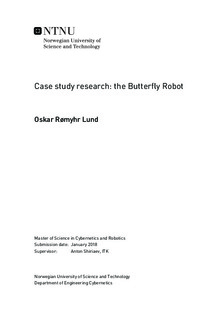| dc.description.abstract | Robots that can only manipulate objects by grasping are very restricted and limited in their
actions. Nevertheless, manipulation by grasping remains a common feature for robots, as it is the easiest way to always maintain control of the states in a system. By developing non-prehensile manipulation for robots the possibility of robots who can use human objects, with the same functionality as humans, is feasible and expected. To gain knowledge of non-prehensile manipulation, a benchmark example known as the Butterfly robot is studied. The benchmark example from 1998 was meant to propose the challenge of developing a systematic technique for non-prehensile manipulation of a rolling motion.
This thesis considers an underactuated dynamic model, which is derived with all the surrounding theory carefully explained. Furthermore, a common assumption applied to the system is investigated to possibly reveal inaccuracies caused by the assumption itself. Virtual-holonomic-constraints-based motion planning is then applied to the system to find
feasible trajectories for the Butterfly robot. | |

